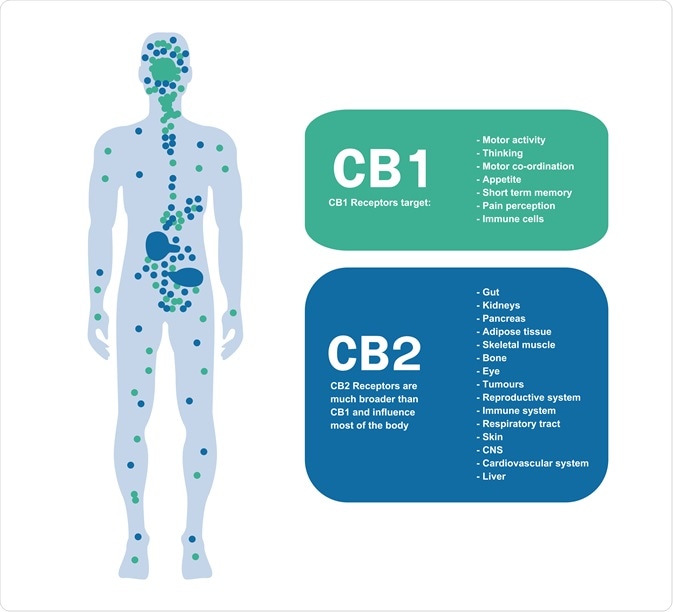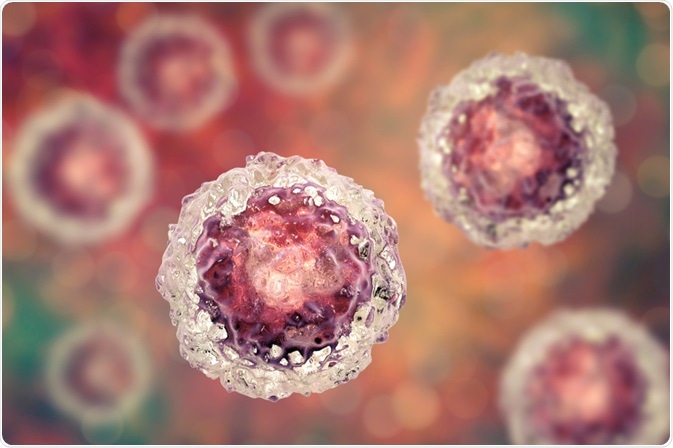There are multiple reasons cannabis is consumed, whether for its psychoactive effects or pain relief. These reasons for consuming cannabis are caused by the ways the different molecules produced by the cannabis plant, the cannabinoids, interact with the body.
.jpg)
Image Credit: Dmytro Tyshchenko/Shutterstock.com
Some cannabinoids have easily defined and well-studied interactions with the central nervous system and periphery cells whereas others work on a wider range of cells making such studies harder. Some cannabinoids interact with the cells through receptors on the cell’s membrane which play a role in differentiation, consequently affecting the differentiated cell’s function.
Molecules of the Cannabis Plant
Cannabis is made up of over 500 natural compounds with over 100 cannabinoids. Cannabinoids are unique to the cannabis plant, with tetrahydrocannabinol (THC) and cannabidiol (CBD) gaining particular interest for their potential effects. THC is the cannabinoid responsible for the majority of the psychoactive effects.
This molecule binds to the G-protein receptors cannabinoid receptor type-1 (CB1) and cannabinoid receptor type-2 (CB2), these two receptors are part of the endocannabinoid system. On the other hand, CBD is anecdotally linked to pain relief and has a more complex relationship with the endocannabinoid system.
CBD displays a mild affinity for CB2 but there is evidence that it enhances the action of the endogenous cannabinoid ligand, anandamide, and is a negative allosteric modulator of CB1. CBD interacts with the endocannabinoid system and has been found to affect various molecules and receptors that are not part of this system.
Endocannabinoid System
The endocannabinoid system is made up of the cell membrane CB1 and CB2 receptors and the endogenous molecules that activate them. These cell receptors are found in various tissues but are not widespread throughout the body.
CB1 receptors are particularly prevalent in the central nervous system and peripheral tissue, whereas CB2 is found in only low densities in the central nervous system but is present in the gastrointestinal tract and on periphery cells with immune function.
The endogenous molecules that interact with the system are called endocannabinoids. These are anandamide and 2-arachidonoyl-glycerol (2-AG). The endocannabinoid system regulates a wide variety of functions in the body and has been linked to cognitive functions such as perception, learning, memory, mood, and anxiety but is also linked to feeding behavior, modulation of pain, and cardiovascular functions.
The prevalence of cognitive associations to the system may be connected to the prevalence of CB1 and CB2 receptors in neurons and neural stem cells.

Image Credit: please buy my work I/Shutterstock.com
Stem Cells
Neural stem cells are imperative in maintaining the functioning of the brain. Neurons cannot divide through mitosis therefore all new neurons are created by neurogenesis, differentiation from neural stem cells. Stem cells are a reservoir of undifferentiated cells within an organism that can be called upon to replace certain cell types.
In cell differentiation there are several stages, pluripotent cells can become any cell of the body, whereas stem cells that are further down the cell fate pathway can only differentiate into associated cells. In the case of neurons, this would be neural stem cells differentiating into neurons or glial cells.
The differentiation is triggered by external factors influencing the stem cells, therefore, if a new molecule interacts with the cell then it could affect the resulting differentiated cell.
Effects of Cannabis on Stem Cells differentiation
In neurogenesis, the quantity of CB1 and CB2 receptors changes through differentiation. During differentiation under normal conditions, the quantity of CB1 receptors increases whereas the CB2 receptors are lost.
However, through investigating the role of these receptors, it was discovered that the stem cells with CB2 receptors artificially removed, displayed impaired proliferation. In contrast, when CB1 was stimulated with cannabinoids it increased neurogenesis. Thus displaying the intimate connection between cannabinoid receptors and differentiation.
This is also demonstrated in prenatal exposure to cannabinoids. Exposure to cannabinoids when the cells are differentiating leads to misplacement of CB1 hippocampal interneurons, reduced cytoskeletal instability, and reduced long-term plasticity in the hippocampus.
The effects of cannabis are not limited to neural stem cell differentiation, the endocannabinoid system also regulates adipose tissue metabolism. During the differentiation of mesenchymal stem cells into adipocytes, the exposure to CBD significantly enhanced lipid accumulation in the newly formed cells.
Additionally, there have been promising results using cannabis on cancer stem cells. Behind some cancers, there are mutant stem cells that uncontrollably multiply. When trialed in breast cancer stem cells the cannabinoid receptor agonists displayed anti-invasion potential, thereby allowing the possibility of using cannabinoids to represses further cancer reoccurrence.

Image Credit: Kateryna Kon/Shutterstock.com
Conclusion
The interaction between cannabis and the endocannabinoid system has been studied with regard to stem cells and differentiation. This complex endocannabinoid system, involving CB1 and CB2 receptors, and is involved with many cognitive processes.
The cannabis plant contains a wide variety of molecules, including THC and CBD, that can licit effects on the CB1 and CB2 receptors of the endocannabinoid system and stem cells. In neurogenesis, the effects were different depending on the cannabis molecule and the time of differentiation.
Although cannabinoid stimulation of CB1 increased neurogenesis in adult tissues, if exposed to the cannabinoids during fetal development, it led to harmful cellular alterations. Whereas in mesenchymal and cancer stem cells the results were productive, increasing the lipid accumulation of adipocytes and suggesting a method of repressing further cancers, respectively.
References
- Fellous, T. et al. (2020) ‘Phytocannabinoids promote viability and functional adipogenesis of bone marrow-derived mesenchymal stem cells through different molecular targets’, Biochemical Pharmacology. Elsevier, 175(October 2019), p. 113859. doi: 10.1016/j.bcp.2020.113859.
- Hill, J. D. et al. (2018) ‘Activation of GPR55 increases neural stem cell proliferation and promotes early adult hippocampal neurogenesis’, British Journal of Pharmacology, 175(16), pp. 3407–3421. doi: 10.1111/bph.14387.
- Maccarrone, M. et al. (2016) ‘Programming and reprogramming neural cells by (endo-) cannabinoids: from physiological rules to emerging therapies’, Nat Rev Neurosci., 15(12), pp. 786–801. doi: 10.1038/nrn3846.Programming.
- Mohammadpour, F. et al. (2017) ‘Anti-invasion effects of cannabinoids agonist and antagonist on human breast cancer stem cells’, Iranian Journal of Pharmaceutical Research, 16(4), pp. 1479–1486. doi: 10.22037/ijpr.2017.2143.
- Piscitelli, F. and Di Marzo, V. (2015) The ever-expanding world of the endocannabinoids: A concise introduction, Cannabinoids in Neurologic and Mental Disease. Elsevier Inc. doi: 10.1016/B978-0-12-417041-4.00024-2.
- Vučkovic, S. et al. (2018) ‘Cannabinoids and pain: New insights from old molecules’, Frontiers in Pharmacology, 9(NOV), pp. 1–19. doi: 10.3389/fphar.2018.01259.
- WHO Expert Committee on Drug Dependence (2017) Cannabidiol (CBD) Pre-Review Report. Available at: https://www.who.int/ (Accessed: 21 May 2020).
- WHO Expert Committee on Drug Dependence (2018) Critical Review - Cannabis and cannabis resin. Available at: https://www.who.int/ (Accessed: 21 May 2020).
Further Reading
Last Updated: Sep 12, 2022